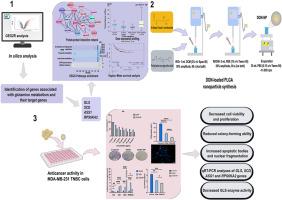负载6-重氮-5-氧-l -去甲亮氨酸(DON)的PLGA纳米颗粒通过抑制谷氨酰胺代谢在三阴性乳腺癌中的抗癌作用:生物信息学和实验的综合方法
IF 4.9
3区 医学
Q1 PHARMACOLOGY & PHARMACY
Journal of Drug Delivery Science and Technology
Pub Date : 2025-09-10
DOI:10.1016/j.jddst.2025.107499
引用次数: 0
摘要
三阴性乳腺癌(TNBC)仍然是一个医学问题,由于没有发现任何“致命弱点”特征,因此没有开发出针对该问题的靶向治疗方法。在本研究中,我们试图通过生物信息学分析阐明TNBC对谷氨酰胺代谢的依赖性,鉴定相关基因,合成6-重氮-5-氧-l -去甲亮氨酸(DON)负载的PLGA纳米颗粒,并在体外评估其针对谷氨酰胺途径的抗癌作用。利用GEO2R工具检测GSE10843、GSE57083、GSE34211、GSE26370和GSE263696数据集,并鉴定差异表达基因(DEGs)。利用KEGG、enrichment和STRING工具进行途径富集分析。用Kaplan-Meier Plotter进行UALCAN基因表达和生存分析。生物信息学结果显示,谷氨酰胺代谢是TNBC中一个显著的代谢靶点。谷氨酰胺拮抗剂DON是一种抑制谷氨酰胺代谢的药物,由于其系统性毒性和特异性不足,在临床研究中失败。采用W/O/W双乳液溶剂蒸发技术合成了DON-NPs。通过ZetaSizer和FT-IR分析进行理化表征,并对MDA-MB-231细胞进行细胞毒性评估。生物信息学分析检测到GLS、ASS1、SCD和RPS6KA2基因的表达,qRT-PCR证实。DON-NPs的尺寸为176.7±4.53 nm, zeta电位为- 40.9±2.78 mV, PDI值为0.242±0.01。DON- nps和DON的IC50值分别为1.9 μg/mL和4 μg/mL。DON- nps表现出比DON更强的抗增殖和凋亡作用,同时降低GLS表达和酶活性。我们的研究结果表明,DON-NPs对谷氨酰胺依赖性TNBC增强了体外抗癌作用。本文章由计算机程序翻译,如有差异,请以英文原文为准。

Anticancer effects of 6-diazo-5-oxo-L-norleucine (DON)-loaded PLGA nanoparticles in triple-negative breast cancer by inhibiting glutamine metabolism: An integrated bioinformatic and experimental approach
Triple-negative breast cancer (TNBC) remains a medical problem for which no targeted therapy has been developed because no "Achilles heel" feature has been identified. In this study, we sought to elucidate the dependence on glutamine metabolism in TNBC by bioinformatics analysis, identify relevant genes, synthesize 6-diazo-5-oxo-L-norleucine (DON)-loaded PLGA nanoparticles, and evaluate their anticancer effects targeting the glutamine pathway in vitro.
The GEO2R tool was utilized to examine the GSE10843, GSE57083, GSE34211, GSE26370, and GSE263696 datasets and identify differentially expressed genes (DEGs). Pathway enrichment analyses were performed utilizing KEGG, Enrichr, and STRING tools. Gene expression in UALCAN and survival analysis were performed with Kaplan-Meier Plotter. Bioinformatic results revealed that glutamine metabolism is a notable metabolic target in TNBC. DON, the glutamine antagonist selected to inhibit glutamine metabolism, has failed in clinical studies due to systemic toxicity and inadequate specificity. DON-NPs were synthesized to overcome these challenges using the W/O/W double-emulsion solvent evaporation technique. Physicochemical characterization was conducted by ZetaSizer and FT-IR analysis, and cytotoxicity was assessed in MDA-MB-231 cells. The expression of GLS, ASS1, SCD, and RPS6KA2 genes detected in bioinformatic analyses was confirmed by qRT-PCR.
The size of DON-NPs was measured at 176.7 ± 4.53 nm, with a zeta potential of −40.9 ± 2.78 mV and a PDI value of 0.242 ± 0.01. The IC50 values of DON-NPs and DON were determined at 1.9 μg/mL and 4 μg/mL, respectively. DON-NPs exhibited greater anti-proliferative and apoptotic effects than DON, along with reduced GLS expression and enzyme activity.
Our results demonstrate that DON-NPs for glutamine-dependent TNBC enhanced anticancer effects in vitro.
求助全文
通过发布文献求助,成功后即可免费获取论文全文。
去求助
来源期刊
CiteScore
8.00
自引率
8.00%
发文量
879
审稿时长
94 days
期刊介绍:
The Journal of Drug Delivery Science and Technology is an international journal devoted to drug delivery and pharmaceutical technology. The journal covers all innovative aspects of all pharmaceutical dosage forms and the most advanced research on controlled release, bioavailability and drug absorption, nanomedicines, gene delivery, tissue engineering, etc. Hot topics, related to manufacturing processes and quality control, are also welcomed.

 求助内容:
求助内容: 应助结果提醒方式:
应助结果提醒方式:


